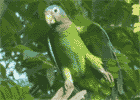 |
 |
The Jamaican Rock Frog (Eleutherodactylus cundalli) is typical for the Family Eleutherodactylidae in that embryos undergo direct development inside the egg: there is no free-swimming tadpole stage. When caves are nearby, this species can take advantage of the 100% relative humidity inside a cave -- eggs won't dry-out -- and the general absence of terrestrial predators (e.g. lizards, birds, other frogs, etc.). Freshwater cave crabs, such as Sesarma verleyi, however, will depredate eggs if they are left unattended.
Unlike most Eleutherodactylidae, the mother, not the father, guards the egg mass as the babies are developing. When the young hatch as tiny froglets, they climb onto the mother's back and she carries them out to the terrestrial forest, where they will be able to find more food than what is available inside a cave.
We owe this photo and all information about Eleutherodactylus cundalli's parental care to Dr. Rudolf Diesel and his co-authors from their 1995 publication. Check out Rudi's excellent web site of nature photography and videography at http://www.Science-Media.de.
The black "blobs" in the photo are the young froglets sitting on their mother's back. The photo was taken inside Windsor Cave, Trelawny, Jamaica.
The recording of a calling male was collected by WRC's Dr. Susan Koenig at the side sump opening
of Windsor Cave.
Reference
Diesel, R., G. Bauerle and P. Vogel. 1995. Cave breeding and froglet transport: a novel pattern of anuran brood
care in the Jamaican frog, Eleutherodactylus cundalli. Copeia 1995:354-360.

